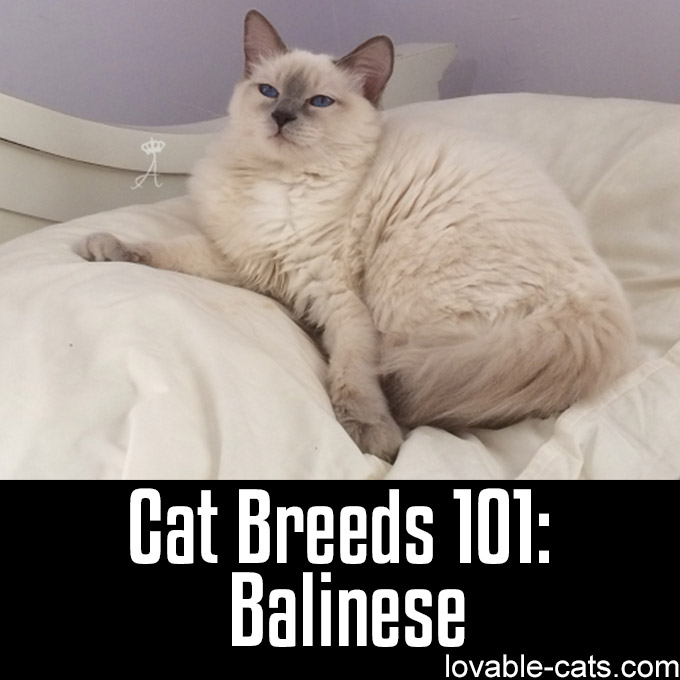
Cat Breeds 101: Balinese – Image To Repin / Share
Photo: Wikipedia – lic. under CC 3.0
The Balinese is recognized as a beautiful and graceful long-haired cat breed – but it was not always esteemed as such. The result of a natural mutation from the short-haired Siamese, the Balinese began its history as the “odd kitty out”, the strange-looking long-haired cat born in a litter of elegantly perfect Siamese kits.
But thanks to the efforts and adoration of Siamese breeders Helen Smith and Marion Dorsey, this cat soon became seen as the swan it really was. In the 1950s, Smith and Dorsey set up a breeding program for the Balinese and turned this fluke of nature into a recognized breed. Then, to complete the rebranding of this once-maligned mutant, Smith gave it the name ‘Balinese’ as a way of putting the spotlight on its graceful and elegant nature, reminiscent of the famed Balinese dancers. And so, the Balinese as we know it today was born. [1]
As a descendant of the Siamese, the Balinese likewise has a slender body, almond eyes, big pointy ears, and long legs. Its eyes, however, are always blue or a similar hue, and its long tail is plumed. Its coat is of the colorpoint pattern, which means that its face, ears, tail, and feet have a darker hue than the rest of its body. [2] The traditional Balinese colors are seal, chocolate, lilac, and blue. [3]
Although the Balinese is a long-haired breed, it requires relatively little care for its coat and is able to make do with just a weekly brushing (although twice or thrice a week would be better). Weekly tooth brushing is also advised, as well as weekly nail trimming, periodic ear cleaning, and annual visits to the vet for professional tooth cleaning.
But that’s just for its physical grooming and hygiene, and with a cat like the Balinese, you still have a long way to go for its complete proper care. This is in fact a rather high-maintenance breed, medium-maintenance at best. With a Balinese in the house, you need to cat-proof your home or your pet will end up dangerously exploring every nook, cranny, box, closet, drawer, pot, pan, cupboard – you get the picture. This is an extremely curious and intelligent cat.
An alternative (or perhaps, augmentation) for kitty-proofing your home is training your cat. Indeed, this breed is only recommended for experienced cat handlers who have the skill, patience, inclination, and time to train their kitty. As playful and gentle and sociable as this breed may be, it is not the kind of cat you want to take home as a playmate for your little kids. [1]
The Balinese, however, may make a scintillating companion for independent-living empty-nest retirees, especially those who miss saying no to uncontrollable-but-adorable chatterboxes living in the same house. [3] The kind of physical and mental stimulation that a pet owner can get from living with a Balinese should be excellent and focused engagement with them may even be beneficial in delaying the onset of physical and mental impairment.
References:
[1] Balinese. Vetstreet. https://www.vetstreet.com/cats/balinese
[2] Balinese cat. Wikipedia. https://en.wikipedia.org/wiki/Balinese_cat
[3] Balinese Cat. Petfinder. https://www.petfinder.com/cat-breeds/Balinese
